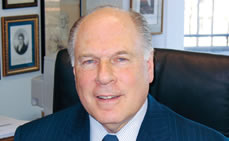THE MATH COLUMN
Using Algebra to Justify Number Curiosities
By Alfred S. Posamentier
 Let’s take a look at an aspect of mathematics – some simple number curiosities – that requires nothing more than the most elementary algebra, and yet is hardly ever shown to our students. This unfortunate oversight of today’s teachers, caused largely because the politics today dictated by the common core standards have made teachers prone to “teach to the test,” since they are evaluated by their students’ performance on standardized tests. These omissions that can enrich instruction and of course excite students about the subject of mathematics, have motivated me to write my most recent book The Joy of Mathematics: Marvels, Novelties, and Neglected Gems that are Rarely Taught in Math Class (Prometheus Books, 2017).
Let’s take a look at an aspect of mathematics – some simple number curiosities – that requires nothing more than the most elementary algebra, and yet is hardly ever shown to our students. This unfortunate oversight of today’s teachers, caused largely because the politics today dictated by the common core standards have made teachers prone to “teach to the test,” since they are evaluated by their students’ performance on standardized tests. These omissions that can enrich instruction and of course excite students about the subject of mathematics, have motivated me to write my most recent book The Joy of Mathematics: Marvels, Novelties, and Neglected Gems that are Rarely Taught in Math Class (Prometheus Books, 2017).
Let’s consider one such phenomenon. There are lots of unusual number patterns and relationships, which often boggle the mind. Some cannot be proved (as yet!), such as the famous Goldbach conjecture, named for the German mathematician Christian Goldbach (1690–1764), who wrote a conjecture in a letter to the famous Swiss mathematician Leonhard Euler in 1742, which states: Every even number greater than 2 can be expressed as the sum of two prime numbers.
Try a few examples to see how this looks in practice. Here are a few examples:
6 = 3 + 3, 18 = 13 + 5, 24 = 19 + 5, and so on. Goldbach also later asserted:
Every odd number greater than 5 can be expressed as the sum of three primes. For example: 11 = 5 + 3 +3, 23 = 11 + 7 + 5, and so on. The latter conjecture, also unproved, is not as widely known as the former. You might want to try verifying these conjectures with larger numbers to perhaps convince yourself that they appear to be true. This will give you a better insight into what is going on here. Let us now consider a “provable” relationship.
One plus the sum of the squares of any three consecutive odd numbers is always divisible by 12.
The beauty of this statement is manifested in the simplicity of the algebraic procedure used to prove it. First, one must establish a way to represent an odd and an even number. For any integer n, 2n will always be even and 2n+1, the next consecutive number, must then be odd.
We begin by letting 2n+1 be the middle number of the three consecutive odd numbers in consideration. Then, since the preceding odd number is 2 less that this, [2n+1] – 2 = 2n – 1 is the next smaller odd number. Similarly, [2n+1] + 2 = 2n+3 is the next larger odd number. We are now ready to represent the relationship we are seeking to prove.
(2n-1)2 + (2n +1)2 + (2n+3)2 + 1 = 12n2 + 12n + 12 = 12(n2 + n + 1) = 12M where M represents some integer. Note that since n is an integer, n2is also an integer, so the sum n2 + n + 1 must also be an integer, and we shall represent that integer as M. We can then conclude that this sum of squares plus one is always divisible by 12. This should be merely a springboard to other similar investigations into number theory. Although we easily used elementary algebra to prove this statement, the two Goldbach conjectures have been around for centuries and countless attempts to prove their veracity have failed, yet no one has yet found an example to show that these conjectures are not true. This is what keeps mathematics alive, challenging and entertaining at the same time. #
Dr. Alfred Posamentier is currently Executive Director for Internationalization and Sponsored Programs, Long Island University, New York.
